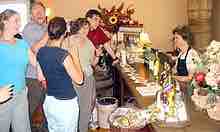Introduction
In 2000, best-selling author Seth Godin released a book entitled "The Idea Virus" and then proceeded to give it away for free. Was Seth, who has sold tons of books, suffering from temporary insanity? No, quite the contrary. You see, Seth knew that if he gave the book away for free, people would read it, and if they liked it they would help create a buzz about the book.That's exactly what happened. In less than a month, 400,000 copies were downloaded for free and even though the downloads were free, people bought the hardcover. The book ended up being #5 on Amazon.com's best seller list. The promotion strategy Seth Godin used is called sampling and when done correctly it can be one of the most effective ways to market your product.
What is Sampling?
A free sample or "freebie" is a portion of food or other product (for example, beauty products) given to consumers in shopping malls, supermarkets, retail stores, or other venues. Sometimes samples of non-perishable items are included in direct marketing mailings.
The purpose of a free sample is to acquaint the consumer with a new product. It is similar to the concept of a test drive, in that a customer is able to try out a product before purchasing it.

Try it, You'll Like it.
This free wine tasting allows potential buyers to try, or sample, the wine before making a purchase.
Many consumer product companies now offer free samples through their websites to encourage consumers to regularly use the products and to gather data for mailing lists of potentially interested customers.
Food courts, grocery stores, and companies such as Costco and Sams Club routinely give out free samples to customers to persuade them to buy the product. Paint chips are samples of paint colors that are sometimes offered as free samples.
The expansion of online marketing with regard to promotional giveaways has facilitated the rise of "Freebie sites" that seek to aggregate all promotional free sample offers in one place. These sites will often compile free product samples from all over the web and categorize them by type.
Some product sample offers may require consumers to complete a survey or refer a friend to qualify for the freebies. When all requirements are fulfilled, the product samples are shipped to the consumer.
Additionally, the advent of the social graph and the realization that consumers take more and more cues from each other's reviews, has opened up a new branch of sampling called social sampling.
History
Soap manufacturer Benjamin T. Babbitt in the 19th century was one of the first known, though almost certainly not the first ever, people to offer free samples of his products.
Other Samples
It is also possible to purchase products in small "trial size" containers. This is common with toiletries such as shampoo, which are useful for vacations or other travel, where large bottles or other containers would be impractical (or more recently, not permitted for air travel). These are also often provided in hotel and motel rooms for the guests.
Samples may also be loaned to the customer if they are too valuable to be given for free, such as samples of a countertop or of carpet to be used for remodeling, or tasting samples as in the Scream Sorbet stand at a farmers market.
How to Create an Effective Sampling Program
Sampling has been around for ages. So it obviously works. But like other promotional programs, bad implementation will lead to bad results. Here are some tips marketers use to create successful sampling programs:
- Find ways to drive new users to your company: Simply giving samples to people who already love your brand or your product is like preaching to the choir. They've already got the message.
- Get permission: You may think that you would never turn down something that is free. But how many free samples of perfume or cologne do you have stuffed in the back of your bathroom cabinet? Taking a sample doesn't turn people into customers unless you have asked permission to give them the sample.
- Encourage trial: To do this, you need to give your samples as close to the point of need as possible. People who are your target audience, but in the wrong setting, will not pay any attention to your samples.
- Start a conversation: Be like Seth Godwin who gave away free copies of his book "The Idea Virus. " Create a buzz.
- Measure your results: Sampling results might not be as easy to measure as other promotional strategies, but they can be measured. It would be mistake not to do so. Seth Godin saw the results of his sampling program not in the number of downloads, but in the number of people who bought the hardcover version of his book.